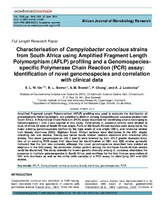| dc.contributor.author | On, S.L.W. | |
| dc.contributor.author | Siemer, B. L. | |
| dc.contributor.author | Brandt, S. M. | |
| dc.contributor.author | Chung, P. | |
| dc.contributor.author | Lastovica, Albert J. | |
| dc.date.accessioned | 2016-06-08T12:16:59Z | |
| dc.date.available | 2016-06-08T12:16:59Z | |
| dc.date.issued | 2013 | |
| dc.identifier.citation | On, S.L.W. et al. (2013). Characterisation of campylobacter concisus strains
from South Africa using amplified fragment length
polymorphism (AFLP) profiling and a genomospecies-specific
polymerase chain reaction (PCR) assay:
Identification of novel genomospecies and correlation
with clinical data. African Journal of Microbiology Research, 7(18): 1845 - 1851 | en_US |
| dc.identifier.issn | 1991-637X | |
| dc.identifier.uri | http://hdl.handle.net/10566/2293 | |
| dc.description.abstract | Amplified Fragment Length Polymorphism (AFLP) profiling was used to evaluate the distribution of
phenotypically indistinguishable, but genetically distinct, among Campylobacter concisus strains from
South Africa. A Polymerase Chain Reaction (PCR) assay described for identifying strains belonging to
Genomospecies 1 and 2 was applied in this study. Forty-seven C. concisus strains were studied in
total, of which 42 were of South African origin. Forty of the South African isolates were assigned to the
major existing genomospecies typified by the type strain of oral origin (GS1), and reference strains
from bloody diarrhoea (GS2). Eighteen South African isolates were distributed in the GS1 cluster
including two oral strains. Twenty-two faecal South African isolates clustered with reference GS2
strains. Two novel genomospecies (GS 5 and 6) were inferred by their AFLP profile characteristics.
Use of an existing PCR assay first described for identification of GS1 and GS2 strains generally
indicated that the tool was accurate, although the novel genomospecies described here yielded an
amplicon in the GS2 assay. No consistent clinical pattern among the diarrhoea South African strains
could be discerned. The study extends the known genetic diversity among C. concisus, elucidates the
presence of multiple genomospecies in South Africa, and confirms for the first time an association of
GS1 with diarrhoea as well as the utility (with caveats) of a PCR assay for identifying GS1 and GS2
strains. | en_US |
| dc.language.iso | en | en_US |
| dc.publisher | Academic Journals | en_US |
| dc.rights.uri | Academic Journals strongly supports the Open Access initiative. Abstracts and full texts of all articles published by Academic Journals are freely accessible to everyone immediately after publication. | |
| dc.source.uri | http://dx.doi.org/10.5897/AJMR12.2182 | |
| dc.subject | Campylobacter | en_US |
| dc.subject | Periodontal disease | en_US |
| dc.subject | Gastroenteritis | en_US |
| dc.subject | Diarrhoea | en_US |
| dc.subject | Red Cross Children's hospital | en_US |
| dc.subject | The Cape Town Protocol | en_US |
| dc.subject | Bacteria | en_US |
| dc.subject | Amplified Fragment Length Polymorphism (AFLP) | en_US |
| dc.subject | Polymerase Chain Reaction (PCR) | en_US |
| dc.subject | Paediatric medicine | en_US |
| dc.title | Characterisation of campylobacter concisus strains
from South Africa using amplified fragment length
polymorphism (AFLP) profiling and a genomospecies-specific
polymerase chain reaction (PCR) assay:
Identification of novel genomospecies and correlation
with clinical data | en_US |
| dc.type | Article | en_US |
| dc.privacy.showsubmitter | FALSE | |
| dc.status.ispeerreviewed | TRUE | |

